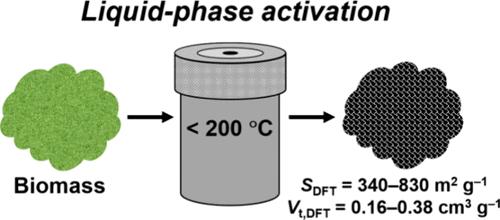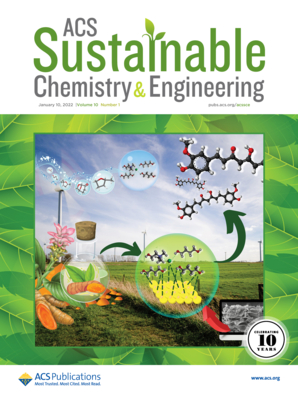Carbonization and Activation of Lignocellulosic Biomass in Liquid Phase at Sub-200 °C Temperatures
IF 7.1
1区 化学
Q1 CHEMISTRY, MULTIDISCIPLINARY
引用次数: 0
Abstract
This work presents a novel solvothermal carbonization and activation method for lignocellulosic biomasses at sub-200 °C temperatures. Common agricultural and forestry biowastes, such as corncobs, rice husks, straw, and sawdust were carbonized and activated by solvothermal treatment in chlorinated solvents in the presence of H2SO4. Unactivated carbonaceous materials were also obtained by omitting H2SO4 from the reaction. The resulting materials were characterized by using nitrogen porosimetry, scanning and transmission electron microscopy, and thermogravimetric analysis. The activated materials achieved specific surface areas as high as 830 m2 g–1 and total pore volumes up to 0.38 cm3 g–1. The porosity consisted mostly of micropores, indicating that the present activation method favors the development of microporosity. The effects of H2SO4 amount, solvent type, temperature, and time on the activated materials were elucidated. To the best of our knowledge, this is the first report of (i) a liquid-based activation process and (ii) an activation process at sub-200 °C temperatures. In addition, the process has many advantages compared with the traditional activation methods that involve temperatures of 500–1000 °C. First, it is less energy-intensive due to the significantly lower temperature. Second, it is less resource intensive due to the smaller amount of activating agent required and no pretreatment or post-treatment steps. Third, it is less polluting, as no VOCs/CO/CO2 fumes are expelled into the atmosphere. Lastly, it involves only a single one-pot step. Overall, the present carbonization and activation process offers an excellent alternative to the common high-temperature carbonization and activation methods.

求助全文
约1分钟内获得全文
求助全文
来源期刊

ACS Sustainable Chemistry & Engineering
CHEMISTRY, MULTIDISCIPLINARY-ENGINEERING, CHEMICAL
CiteScore
13.80
自引率
4.80%
发文量
1470
审稿时长
1.7 months
期刊介绍:
ACS Sustainable Chemistry & Engineering is a prestigious weekly peer-reviewed scientific journal published by the American Chemical Society. Dedicated to advancing the principles of green chemistry and green engineering, it covers a wide array of research topics including green chemistry, green engineering, biomass, alternative energy, and life cycle assessment.
The journal welcomes submissions in various formats, including Letters, Articles, Features, and Perspectives (Reviews), that address the challenges of sustainability in the chemical enterprise and contribute to the advancement of sustainable practices. Join us in shaping the future of sustainable chemistry and engineering.
 求助内容:
求助内容: 应助结果提醒方式:
应助结果提醒方式:


